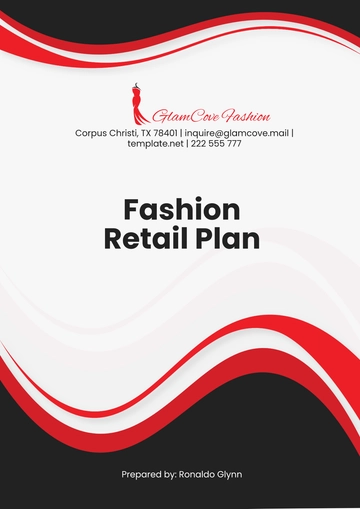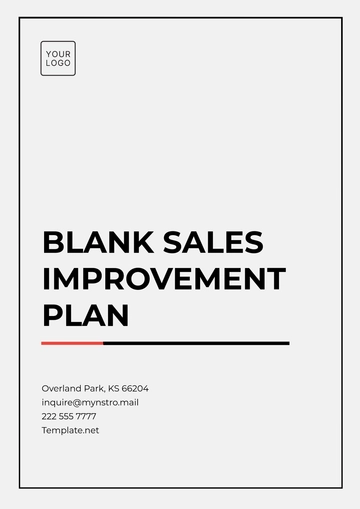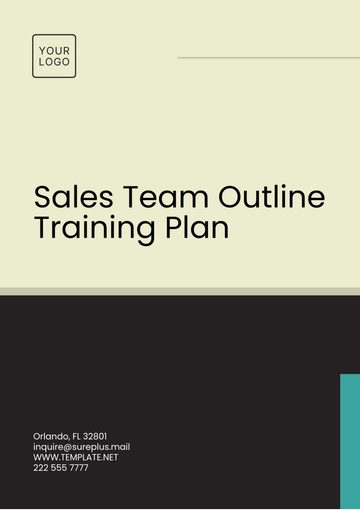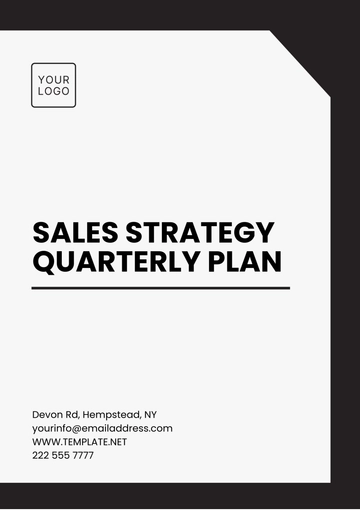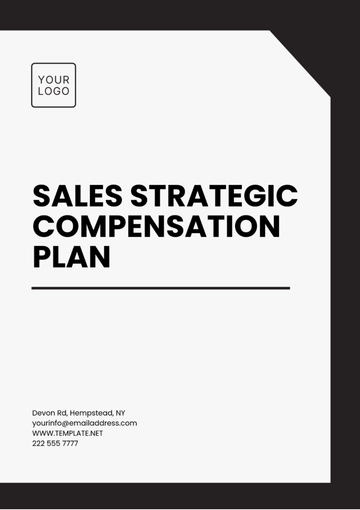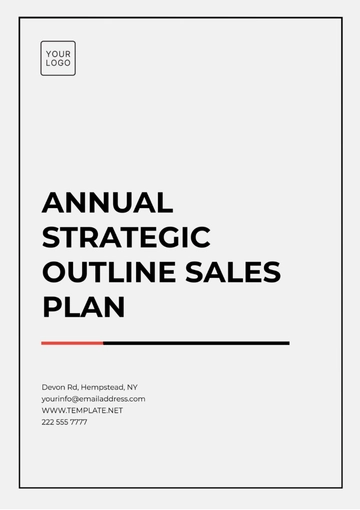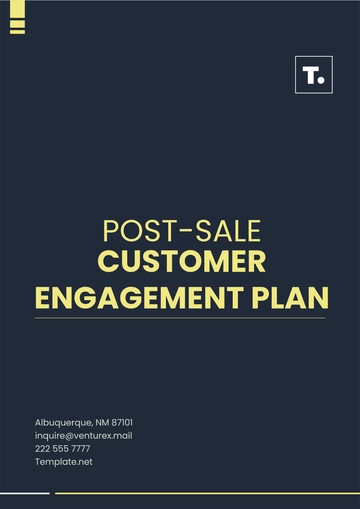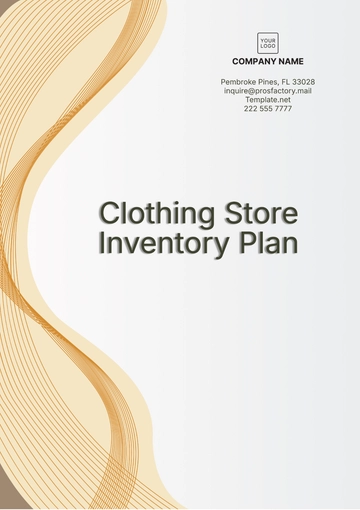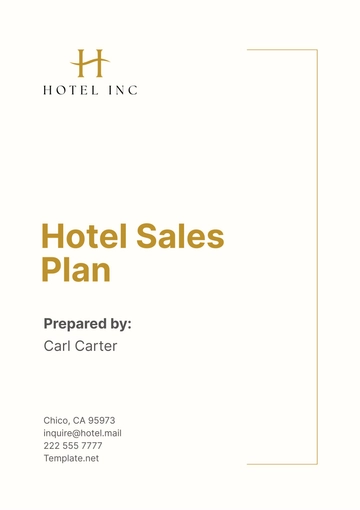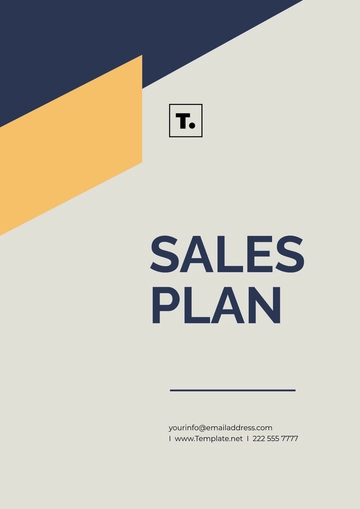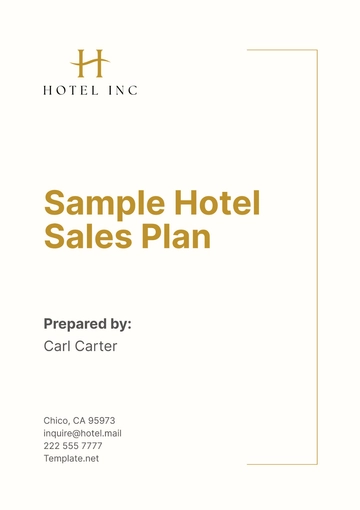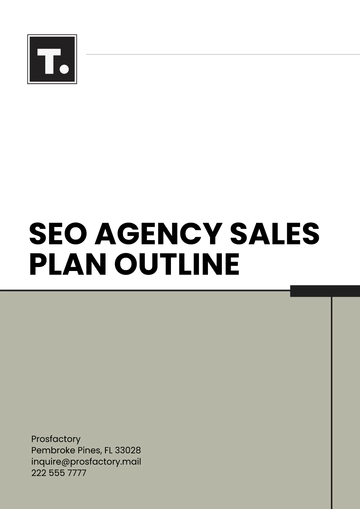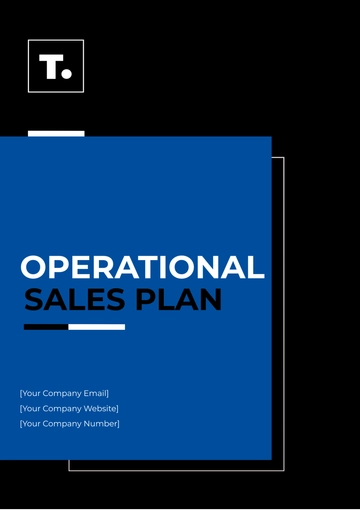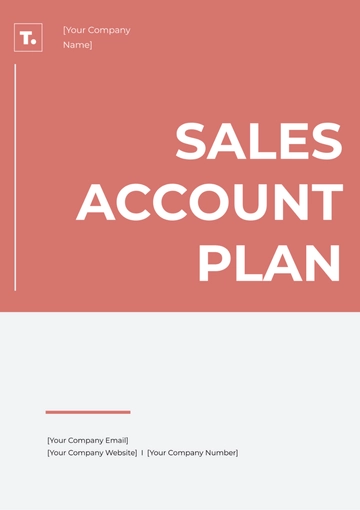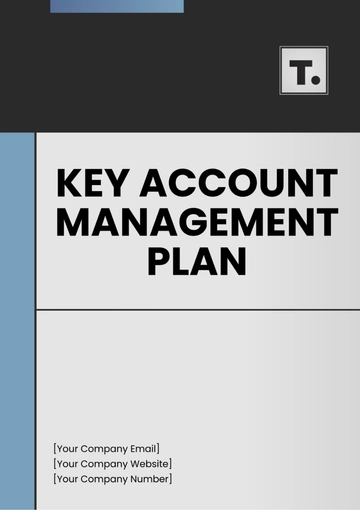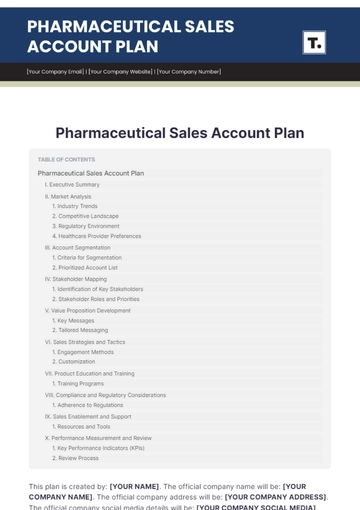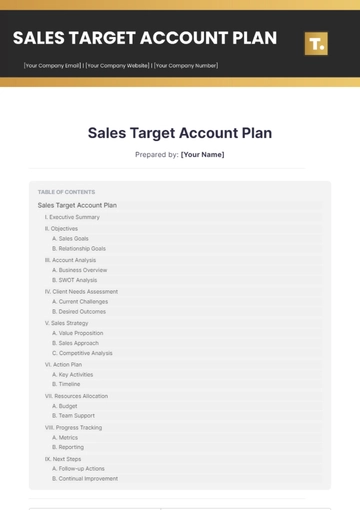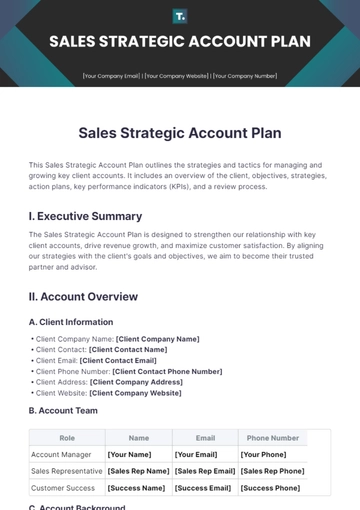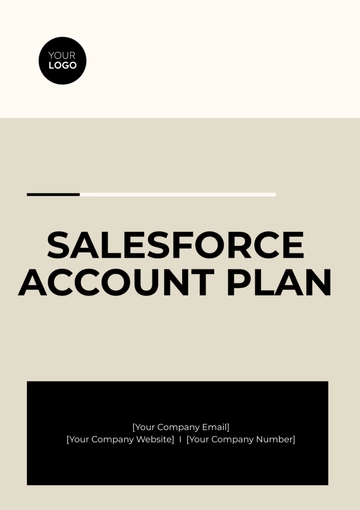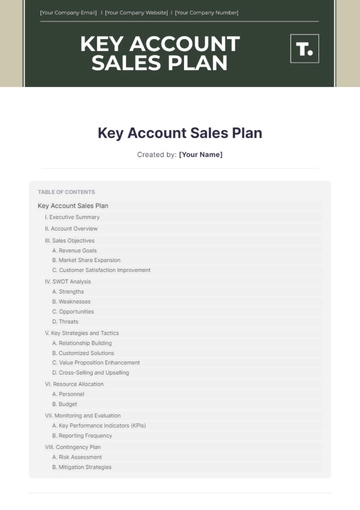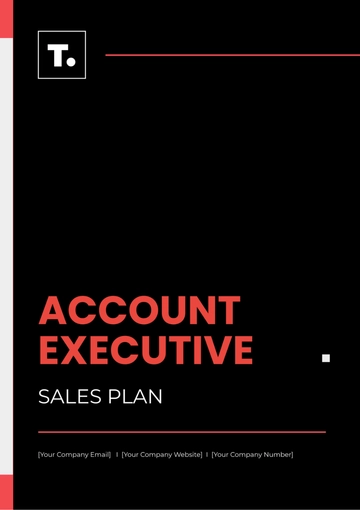Free Sales Plan for Enhancing Customer Loyalty
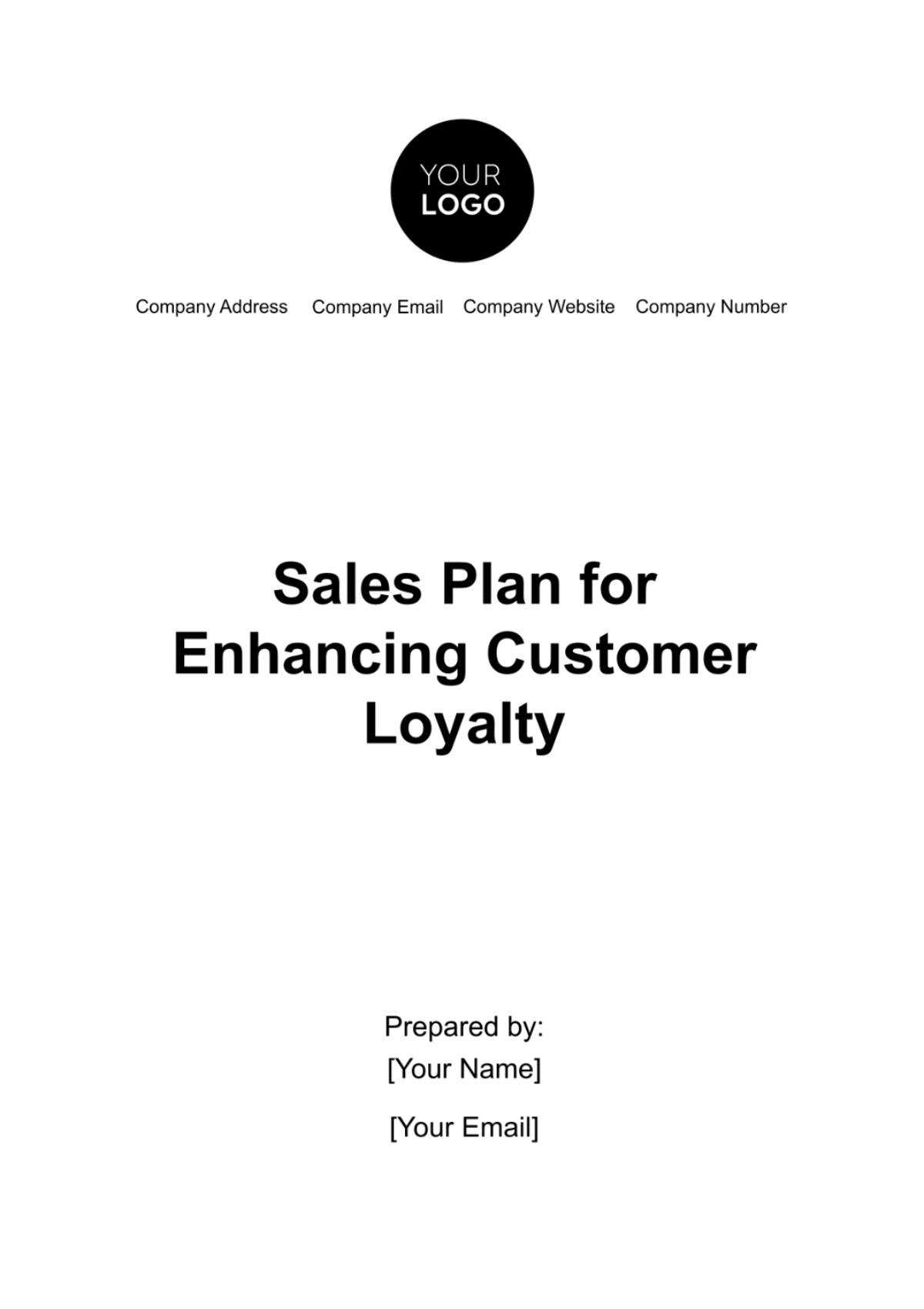
A. Objective Setting and Overview
Cultivating customer loyalty stands as [Your Company Name]’s foundation for long-term success! Recent research indicates that acquiring a new customer can cost up to five times more than retaining an existing one. Moreover, a mere [5%] increase in customer retention can result in a [25%] to [95%] growth in profits.
This era has made it necessary for brands to not only meet but exceed customer expectations consistently. By delving deeper into the core concepts of customer loyalty and its undeniable impact on business expansion, companies can strategically position themselves to thrive in this competitive environment.
Definition of Customer Loyalty:
Customer loyalty is the outcome of consistently positive emotional experiences and high-perceived value from a brand, leading to repetitive purchases. It's more than just a habit; it's an emotional connection between the customer and the brand. A survey made by [Your Company Name]’s research teams found that [68%] of loyal customers believe that brands care about them personally, underscoring the emotional complexities of loyalty.
Importance of Customer Loyalty to Business Growth:
Personal recommendations have become a standard that [Your Company Name] should utilize at its full potential. A study made by business research teams found that [92%] of consumers trust recommendations from friends and family over all other forms of advertising. Hence, the significance of loyal customers, who not only buy but also advocate for the brand, cannot be overstated or overlooked.
Key Objectives of the Plan:
Increase repeat purchases by [10%] over the next year By focusing on targeted campaigns, personalized offerings, and superior customer service, we aim to drive a notable rise in repeat purchases. Recent data from [Your Company Name] revealed that repeat customers, on average, spend [33%] more than new ones, emphasizing the potential revenue uplift from this initiative. |
Strengthen customer engagement on all digital platforms by [20%] Customer interactions across our digital platforms, be it [Your Company Website] or our presence on social media channels, have become critical touchpoints. By enhancing user experience, content relevance, and interactive engagements, we project a significant boost in digital engagement metrics, further solidifying customer loyalty. |
B. Customer Analysis and Segmentation
Understanding our customers’ wants and needs is central to any business strategy. Having a comprehension of who your customers are, what they desire, and how they behave is of great importance. By employing a rigorous process of analysis and segmentation, businesses can not only cater to the existing customer base more efficiently but also predict and drive future consumer behaviors. As we delve into our customer profiles, we will seek the patterns that will further elevate our brand's value proposition.
Demographic, Psychographic, and Behavioral Analysis:
Our analysis shows a pronounced increase of our core audience, predominantly males and females aged between [25 and 45]. This cohort represents consumers who are digitally savvy and rely extensively on online reviews and feedback before making a purchase. Moreover, their buying behavior signals a clear preference for quality, even if it comes with a slightly higher price tag.
Customer Pain Points and Preferences:
Our in-depth interactions and feedback sessions have highlighted some pressing concerns. Here are the pain points and preferences that [Your Company Name]’s customers experience accordingly:
Customer Facet | Pain Points |
Product/Service |
|
Price |
|
Customer Service |
|
Communication |
|
Convenience |
|
Brand Trust |
|
Customization |
|
Technology |
|
Customer Facet | Preferences |
Product/Service |
|
Price |
|
Customer Service |
|
Communication |
|
Convenience |
|
Brand Trust |
|
Customization |
|
Technology |
|
A report from [Your Company Name]’s research teams indicates that [45%] of online shoppers consider delayed shipping a major deterrent. Our internal data supports this, with delayed shipping emerging as a significant pain point. Another area of improvement is the diversity in our product range.
Our customers immensely value swift responses from customer service and have shown a keen interest in a loyalty rewards program. Recognizing these insights can be pivotal in designing interventions that not only address grievances but also enhance the overall brand experience.
Segmenting Customers Based on Loyalty Potential:
The concept of segmentation takes on a new aspect when viewed through the lens of loyalty. By categorizing our customers into Platinum, Gold, and Silver segments, we're not merely quantifying their purchase frequency but identifying champions of our brand.
Platinum Customers This elite group, having made over [five purchases] in the past year, represents our brand ambassadors. They're not only frequent buyers but also potential influencers whose feedback and advocacy can be pivotal. |
Gold Customers This segment, with [3-5 purchases] in the last year, exhibits strong brand preference. With the right nudges and incentives, they hold the promise of transitioning to the platinum category. |
Silver Customers Those who've purchased [1-2 times] in the past year. They represent a mix of newer customers and those we need to re-engage. Tailored outreach and special offers can play a significant role in cementing their loyalty. |
By operationalizing these segments, we can design bespoke campaigns and initiatives that resonate deeply with each group, paving the way for sustained brand loyalty.
C. Loyalty Program Development
Loyalty programs can serve as an effective tool to not only retain existing customers but also to transform them into ardent brand advocates. As we proceed to detail the nuances of our loyalty program, we emphasize its foundation on two pillars: tangible rewards and genuine engagement. Let's explore how [Your Company Name]'s proposed loyalty program seeks to redefine customer-brand relationships.
Loyalty Tiers and Benefits:
The essence of any successful loyalty program lies in its ability to make customers feel valued and acknowledged. By stratifying our program into distinct tiers, we aim to cater to the varied engagement levels of our patrons.
Platinum Designed for our most frequent shoppers, the Platinum tier offers unparalleled benefits. Apart from granting access to exclusive sales, members in this bracket enjoy a consistent [10% discount] on all their purchases. |
Gold Targeted toward our emerging loyalists, the Gold tier strikes a balance between accessibility and exclusivity. Early access to new product launches ensures these customers always stay ahead of the curve. Moreover, a tiered discount system incentivizes higher spending, with a notable [5%] off on purchases exceeding [$50]. |
Silver The Silver tier, while being the entry point to our loyalty program, promises no less in terms of rewards. Personalized birthday discounts not only foster a sense of belonging but also drive sales. Additionally, sporadic surprise rewards serve as delightful reminders of the brand's appreciation for their patronage. |
Reward Systems:
While tier-based benefits create differentiation, our universal point-based reward system aims to ensure every purchase feels rewarding. For every dollar spent by a member, they accrue points in their loyalty account. These points can be effortlessly redeemed against future purchases or exclusive products, making every shopping experience with [Your Company Name] a cycle of earning and redeeming. The research team suggests that such point systems can increase customer retention by up to [15%].
Customer Feedback and Engagement Mechanisms:
To ensure our program remains aligned with our customers' evolving preferences, we're introducing a monthly survey exclusively for members. This not only serves as a platform for customers to voice their opinions but also as a treasure trove of insights for us. To make participation enticing, members will be awarded bonus points, thereby creating a win-win scenario.
D. Communication and Engagement Strategy
Communication is, and will always be pivotal to a brand’s success. A meticulously crafted communication strategy can mean the difference between an engaged customer and a missed opportunity. With the primary goal of fortifying the bond between [Your Company Name] and its clientele, our approach seeks to blend the best of personalization, exclusivity, and responsiveness.
Personalized Customer Communication:
Personalization stands as the key for modern-day customer engagement. Generic, one-size-fits-all communication often gets lost in the crowded consumer's inbox. To counter this, our email campaigns will harness sophisticated algorithms to tailor product recommendations meticulously. These recommendations will be a culmination of a user's past purchases and their browsing behavior on [Your Company Website].
Special Events and Exclusive Perks for Loyal Customers:
To celebrate and acknowledge our most loyal customers, we are introducing quarterly virtual events. These events will serve as a platform to showcase our upcoming product line, offering Platinum and Gold members the privilege of a sneak peek. Apart from the product showcase, these sessions will also feature interactive Q&A segments, behind-the-scenes glimpses, and surprise giveaways.
Tracking and Utilizing Customer Feedback for Improvements:
Feedback isn't just a metric; it's the voice of our customers echoing their experiences, desires, and concerns. To ensure this voice translates into actionable insights, feedback from our monthly loyalty program surveys will be subjected to thorough analysis. Furthermore, these insights will be tabled and discussed in our quarterly team meetings. This iterative feedback loop ensures that product development and service improvements are continually aligned with customer expectations.
E. Monitoring and Evaluation
This section delves deep into the mechanisms [Your Company Name] aims to implement to ensure that our loyalty endeavors not only meet but exceed their intended goals, fostering an ecosystem of perpetual improvement.
Key Performance Indicators (KPIs) for Loyalty Enhancement:
Identifying the right metrics is important to ascertain the success of our loyalty initiatives. These KPIs are the following:
Rate of Repeat Purchases This metric will provide insights into how effective our loyalty program is in incentivizing customers to return and make additional purchases. |
Engagement Rate with Loyalty Program Emails and Events Tracking engagement rates—be it through email opens, clicks, or event participation—will give us a clear picture of our program's resonance with the audience. |
Data Collection and Analysis Methods:
Having plenty of data isn't a challenge; making sense of it is. To ensure we gather all of these data effectively:
Google Analytics This tool will track digital footprints, capturing metrics like site visits, bounce rates, and time spent. Such metrics are vital to gauge the efficacy of our loyalty program in driving online traffic. |
CRM System A strong CRM system will maintain a comprehensive record of customer purchase histories. By analyzing trends in this data, we can tailor our offerings more adeptly to customer preferences. |
Periodic Review and Adjustments:
Stagnancy can be very detrimental. Recognizing this, we will conduct a rigorous bi-annual review of our loyalty program. Insights from this review will inform necessary adjustments, ensuring our program remains at the forefront of customer delight.
F. Training and Team Alignment
A company's ethos and workforce alignment can be its most significant differentiators. While product quality and marketing strategies hold weight, the real magic happens when the entire team, regardless of their role, becomes an ambassador of customer satisfaction.
Importance of a Customer-Centric Culture:
A customer’s experiences, testimonials, and feedback shape our brand's narrative in the market, but how is such a narrative built? It's a combination of interactions across various touchpoints. Be it the sales executive explaining product features or the logistics team ensuring timely deliveries, every department plays a role in sculpting the customer journey.
Training Programs for Sales and Support Staff:
Knowledge empowers, and to ensure our team has the right tools at their disposal, we've instituted monthly workshops. These sessions cover:
Effective Communication Emphasizing active listening and understanding the unspoken needs of the customers, leading to more fulfilling interactions. |
Understanding Customer Needs Harnessing techniques like empathy mapping and journey mapping to step into the shoes of the customer. |
CRM System Mastery Given the importance of data in shaping customer interactions, comprehensive training on our CRM ensures that every team member can glean insights and tailor their approaches accordingly. |
Encouraging Team Feedback for Program Improvement:
Innovation often stems from the grassroots level. Recognizing the value of diverse perspectives, we have established quarterly brainstorming sessions. Here, team members from varied departments come together in a symbiotic environment, sharing suggestions, experiences, and ideas. By gathering these collective insights, we aim to continually refine and elevate our customer loyalty strategies.
Role of Leadership in Championing Loyalty Initiatives:
Our leaders will play an instrumental role in championing our loyalty initiatives. Through regular updates, they'll highlight program successes, share customer testimonials, and emphasize how every role, no matter how big or small, contributes to the tapestry of customer loyalty.
G. Conclusion
This plan for [Your Company Name] presents a comprehensive approach to enhancing customer loyalty. Through targeted strategies, regular data analysis, and a commitment to continuous improvement, we aim to build stronger, lasting relationships with our customers, driving both satisfaction and business growth
- 100% Customizable, free editor
- Access 1 Million+ Templates, photo’s & graphics
- Download or share as a template
- Click and replace photos, graphics, text, backgrounds
- Resize, crop, AI write & more
- Access advanced editor
Elevate your customer retention strategy with Template.net's Sales Plan for Enhancing Customer Loyalty Template. Expertly designed for effortless implementation, this tool streamlines your approach, ensuring repeat business. Dive in, customize with ease, and watch loyalty soar. Your blueprint to unbeatable customer commitment awaits. Get ready-made documents from our official website now!
You may also like
- Finance Plan
- Construction Plan
- Sales Plan
- Development Plan
- Career Plan
- Budget Plan
- HR Plan
- Education Plan
- Transition Plan
- Work Plan
- Training Plan
- Communication Plan
- Operation Plan
- Health And Safety Plan
- Strategy Plan
- Professional Development Plan
- Advertising Plan
- Risk Management Plan
- Restaurant Plan
- School Plan
- Nursing Home Patient Care Plan
- Nursing Care Plan
- Plan Event
- Startup Plan
- Social Media Plan
- Staffing Plan
- Annual Plan
- Content Plan
- Payment Plan
- Implementation Plan
- Hotel Plan
- Workout Plan
- Accounting Plan
- Campaign Plan
- Essay Plan
- 30 60 90 Day Plan
- Research Plan
- Recruitment Plan
- 90 Day Plan
- Quarterly Plan
- Emergency Plan
- 5 Year Plan
- Gym Plan
- Personal Plan
- IT and Software Plan
- Treatment Plan
- Real Estate Plan
- Law Firm Plan
- Healthcare Plan
- Improvement Plan
- Media Plan
- 5 Year Business Plan
- Learning Plan
- Marketing Campaign Plan
- Travel Agency Plan
- Cleaning Services Plan
- Interior Design Plan
- Performance Plan
- PR Plan
- Birth Plan
- Life Plan
- SEO Plan
- Disaster Recovery Plan
- Continuity Plan
- Launch Plan
- Legal Plan
- Behavior Plan
- Performance Improvement Plan
- Salon Plan
- Security Plan
- Security Management Plan
- Employee Development Plan
- Quality Plan
- Service Improvement Plan
- Growth Plan
- Incident Response Plan
- Basketball Plan
- Emergency Action Plan
- Product Launch Plan
- Spa Plan
- Employee Training Plan
- Data Analysis Plan
- Employee Action Plan
- Territory Plan
- Audit Plan
- Classroom Plan
- Activity Plan
- Parenting Plan
- Care Plan
- Project Execution Plan
- Exercise Plan
- Internship Plan
- Software Development Plan
- Continuous Improvement Plan
- Leave Plan
- 90 Day Sales Plan
- Advertising Agency Plan
- Employee Transition Plan
- Smart Action Plan
- Workplace Safety Plan
- Behavior Change Plan
- Contingency Plan
- Continuity of Operations Plan
- Health Plan
- Quality Control Plan
- Self Plan
- Sports Development Plan
- Change Management Plan
- Ecommerce Plan
- Personal Financial Plan
- Process Improvement Plan
- 30-60-90 Day Sales Plan
- Crisis Management Plan
- Engagement Plan
- Execution Plan
- Pandemic Plan
- Quality Assurance Plan
- Service Continuity Plan
- Agile Project Plan
- Fundraising Plan
- Job Transition Plan
- Asset Maintenance Plan
- Maintenance Plan
- Software Test Plan
- Staff Training and Development Plan
- 3 Year Plan
- Brand Activation Plan
- Release Plan
- Resource Plan
- Risk Mitigation Plan
- Teacher Plan
- 30 60 90 Day Plan for New Manager
- Food Safety Plan
- Food Truck Plan
- Hiring Plan
- Quality Management Plan
- Wellness Plan
- Behavior Intervention Plan
- Bonus Plan
- Investment Plan
- Maternity Leave Plan
- Pandemic Response Plan
- Succession Planning
- Coaching Plan
- Configuration Management Plan
- Remote Work Plan
- Self Care Plan
- Teaching Plan
- 100-Day Plan
- HACCP Plan
- Student Plan
- Sustainability Plan
- 30 60 90 Day Plan for Interview
- Access Plan
- Site Specific Safety Plan

